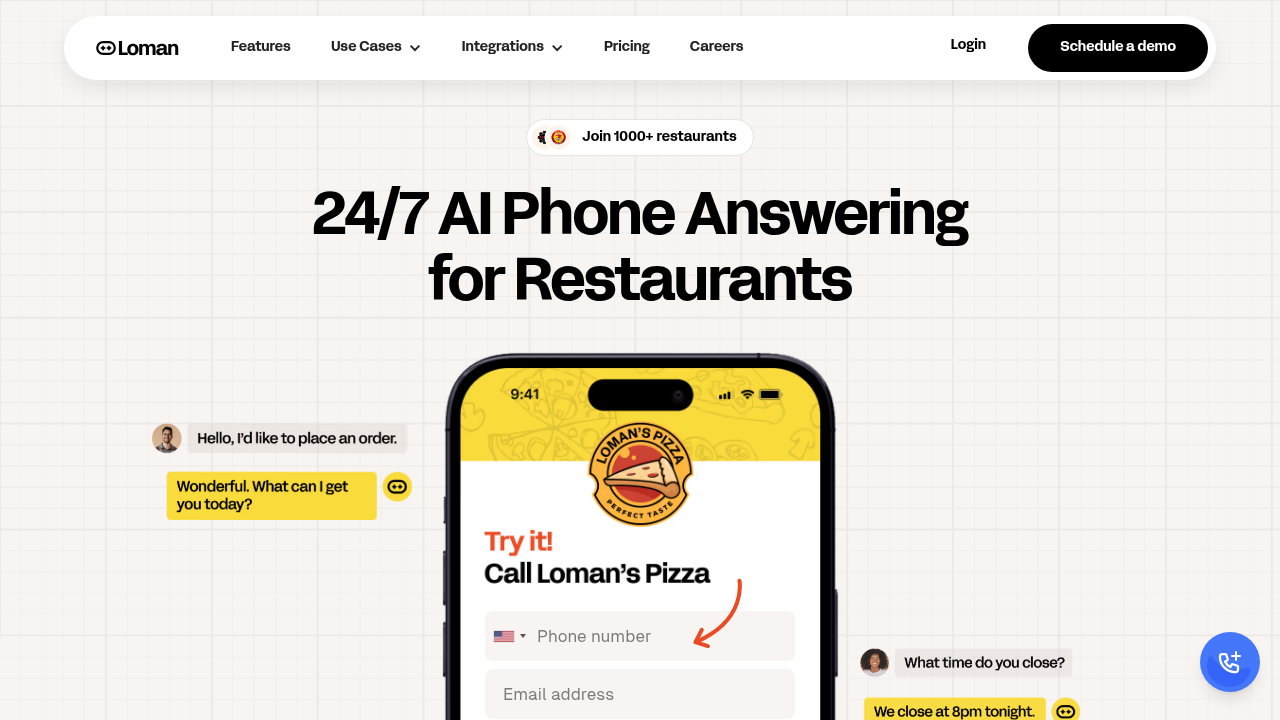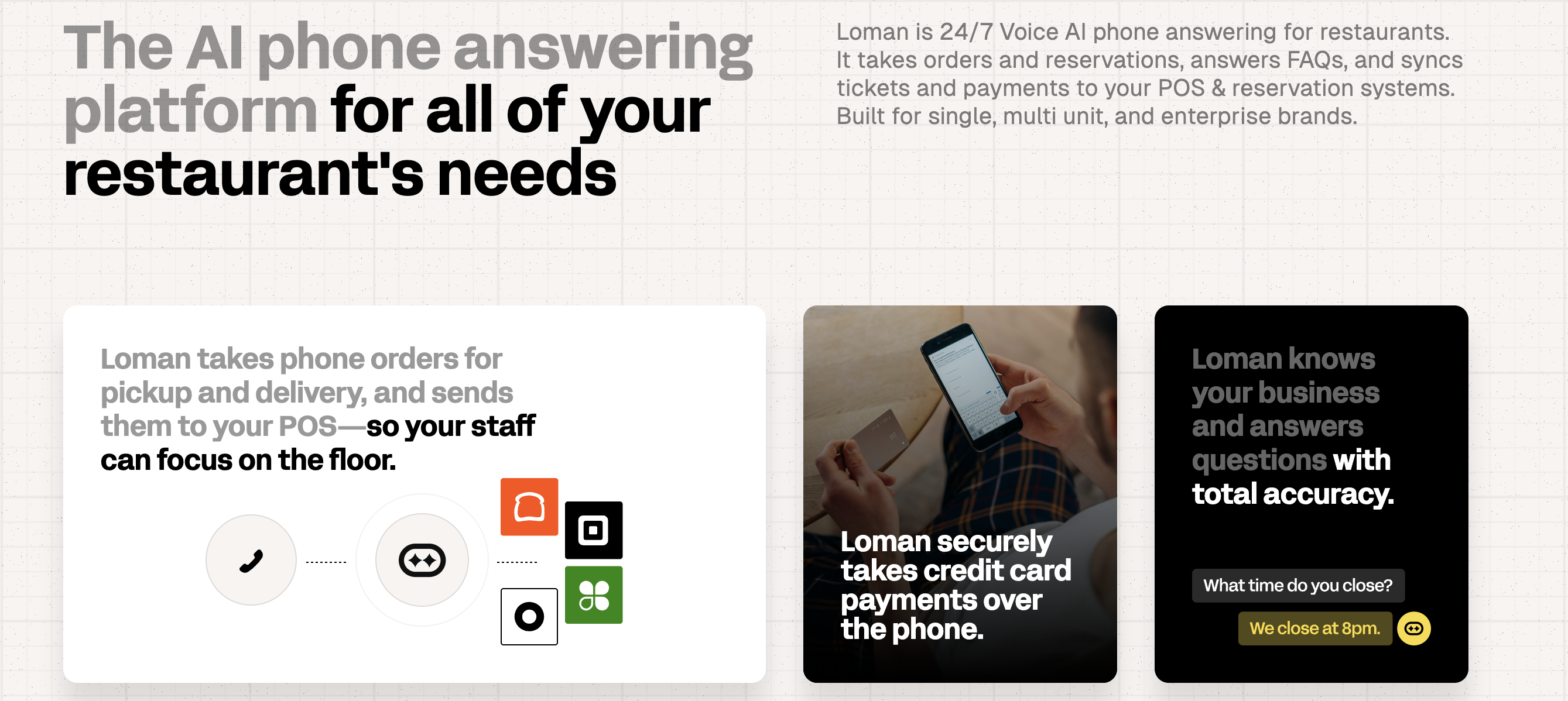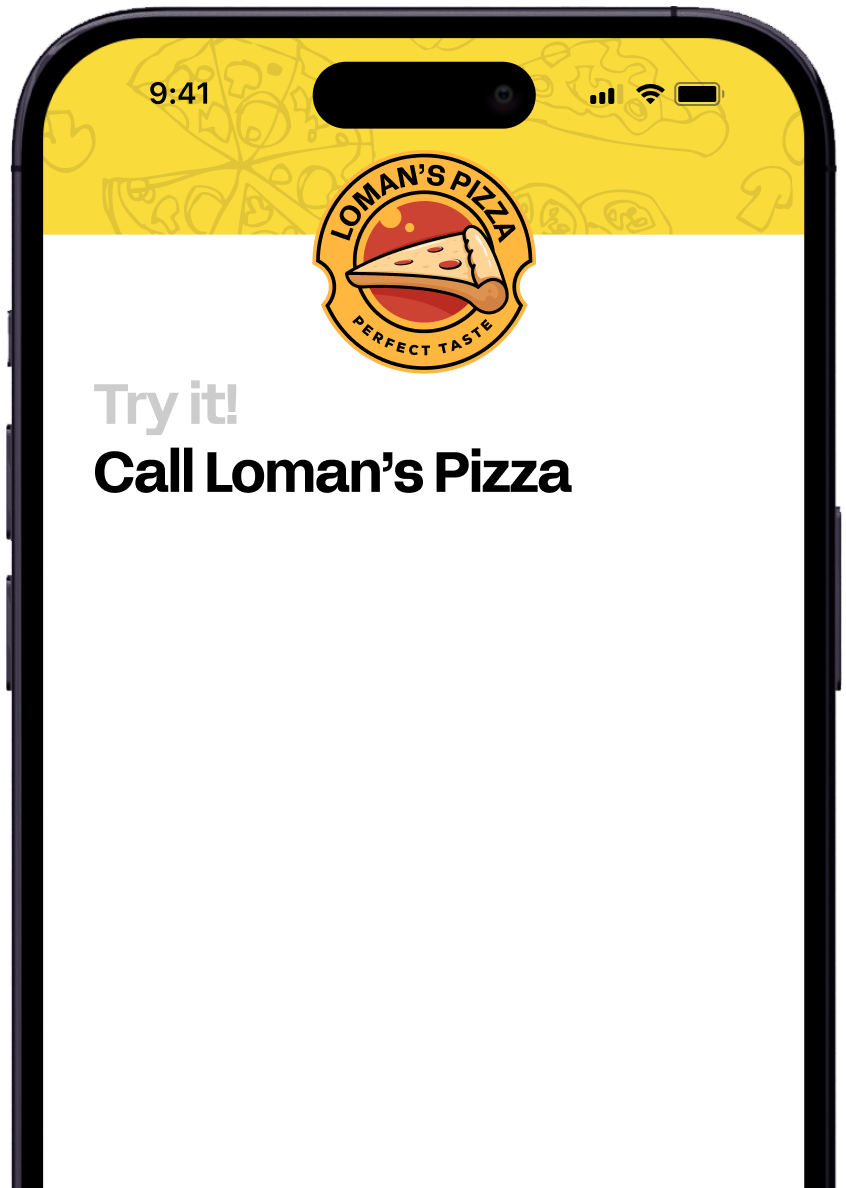November 2, 2025

You've probably called a restaurant to place an order only to get put on hold, transferred around, or told to order online instead. It's frustrating when you just want to grab dinner without jumping through hoops. Both Slang.ai and VOICEplug AI promise to solve these phone problems, but they each have gaps that leave restaurants and customers dealing with the same old friction. Fortunately, there are restaurant voice AI solutions that actually handle the complete customer experience from greeting to payment.
TLDR:
Slang.ai redirects callers to online ordering instead of taking orders directly over the phone
VOICEplug processes orders but lacks reservation management and hospitality features
Both solutions have setup complexity and don't handle unlimited simultaneous calls effectively
Restaurants lose revenue when voice AI systems redirect customers instead of completing sales
Loman combines complete order processing with reservation management and deploys in under 24 hours

Slang.ai positions itself as a hospitality-focused voice AI that handles restaurant phone calls with a conversational approach. The system answers calls 24/7 and manages basic customer interactions like reservation inquiries, menu questions, and general restaurant information.
Callers can speak naturally instead of working through rigid phone menus, and the AI responds with what Slang.ai describes as a warm, human-like tone.
Slang.ai focuses primarily on directing customers to existing online ordering systems instead of taking orders directly through the phone conversation.
Slang.ai handles reservation management and can field questions about hours, location, and basic menu items. For private dining inquiries, it captures lead information for follow-up by restaurant staff.
However, Slang.ai's approach has notable limitations. It doesn't take complete orders over the phone or process payments directly. Instead, it guides customers toward online ordering options or transfers them to staff for complex requests.
This creates friction in the customer experience. When someone calls to place an order, they're redirected to another channel instead of completing their purchase immediately. For restaurants dealing with high call volumes or customers who prefer phone ordering, this gap can mean lost revenue opportunities.
While Slang.ai serves as a basic phone answering solution, restaurants looking for complete order management need more full-featured tools. That's where solutions like Loman stand out by handling the entire customer journey from initial call to payment processing.

VOICEplug AI takes a multi-channel approach to restaurant voice ordering, covering phone calls, drive-thru lanes, and self-service kiosks. Their solution answers calls in under one second and focuses heavily on order accuracy and speed.
VOICEplug processes customer requests and can make menu recommendations based on order history. The platform integrates with existing POS solutions to simplify order processing and handles payment through stored customer information.
Drive-thru features distinguish VOICEplug from basic phone answering services. The platform manages the entire drive-thru experience, from greeting customers to processing complex orders with modifications and upsells.
VOICEplug's strength lies in high-volume order processing across multiple touchpoints, making it appealing for QSR chains and drive-thru focused operations.
However, VOICEplug's approach has gaps in complete restaurant management. It doesn't handle reservation booking, which limits its usefulness for full-service restaurants. Their focus on order processing means less attention to customer service elements like answering detailed menu questions or managing special requests.
The multi-channel approach can also create complexity for smaller restaurants that don't need drive-thru or kiosk integration. Single-location operators often need simpler solutions that handle phone orders alongside reservations and customer inquiries.
While VOICEplug does well with order processing speed, restaurants need more than just ordering features. Solutions like Loman provide the complete package: voice ordering plus reservation management, multilingual support, and restaurant-specific workflow integration that covers every aspect of phone-based customer interactions.
The biggest difference between these solutions becomes clear when customers actually want to place orders. Slang.ai handles basic inquiries but redirects customers to online ordering when they want to purchase food. This creates an extra step that can lose impatient customers.
VOICEplug AI takes the opposite approach, processing orders directly through the phone conversation. It captures menu items, modifications, and customer preferences while integrating with POS systems for immediate order processing.
VOICEplug's order processing delivers up to 25% fewer abandoned orders by eliminating the need to redirect customers to different ordering channels.
However, VOICEplug's technical focus creates its own limitations. It handles high-volume, standardized orders but struggles with complex menu questions or special dietary requests that require detailed responses.
Slang.ai's conversational strength helps with customer service but doesn't translate into actual revenue generation. When customers call to order, they're sent elsewhere to complete their purchase.
Both solutions miss critical elements that restaurants need for complete order management. Neither handles unlimited simultaneous calls effectively during peak hours. VOICEplug processes orders but lacks the restaurant-specific training that helps with menu accuracy and upselling.
The payment processing gap is major too. Slang.ai doesn't handle payments at all, while VOICEplug relies on stored customer information instead of secure real-time payment processing.
For restaurants that need complete call handling features, solutions like Loman bridge these gaps by combining conversational AI with complete order processing, secure payment handling, and restaurant-specific workflow integration that covers every customer interaction from greeting to payment confirmation.
Slang.ai offers basic POS connectivity mainly for tracking and analytics purposes. These integrations focus on capturing call data and customer interactions instead of processing actual orders. This approach works for restaurants that want call metrics but creates workflow gaps when customers need immediate order processing.
The setup process involves connecting existing systems to monitor phone interactions. However, since Slang.ai redirects customers to online ordering, the POS integration doesn't handle real-time order sync during phone conversations.
VOICEplug AI takes a more complete technical approach with integrations across 50+ restaurant technology platforms. These connections include POS systems, online ordering, loyalty programs, and payment processors, creating a unified ecosystem for order management.
VOICEplug's support for many technologies allows restaurants to maintain consistent customer data across all ordering channels.
However, VOICEplug's broad integration strategy can create complexity during setup. Restaurants need technical expertise to configure multiple connections, and the voice AI implementation process often requires weeks of testing and optimization.
Both solutions struggle with real-time menu synchronization. When restaurants update prices or availability in their POS, these changes don't always reflect immediately in the voice AI, leading to order accuracy issues.
The deployment timeline differs greatly. Slang.ai's basic integration can be faster since it handles fewer functions, while VOICEplug's full setup requires more configuration time.
For restaurants seeking smooth POS integration, Loman offers native connections with major POS providers like Toast, Square, and Clover. Our AI technology integration allows same-day deployment with automatic menu sync and real-time order processing that eliminates technical complexity while maintaining complete functionality.
Slang.ai starts at $199 per month for basic call handling and FAQ management. However, this pricing only covers conversation and redirection services since it doesn't process actual orders or payments. Restaurants still need separate solutions for order taking and payment processing.
VOICEplug offers flat-rate pricing for their Plus tier, which works well for smaller restaurants with predictable call volumes. Their Enterprise and Premium plans use variable pricing based on call traffic and feature requirements, making costs less predictable during busy periods.
The value proposition differs greatly between providers. Slang.ai focuses on customer service improvement but doesn't directly generate revenue since customers get redirected for actual purchases. VOICEplug processes orders directly, creating immediate revenue opportunities.
Restaurant voice AI solutions are generating additional revenue of $3,000 to $18,000 per month per location, up to 25 times the cost of the AI system itself.
However, both solutions have hidden costs that affect total value. Slang.ai requires additional ordering systems to complete customer purchases. VOICEplug's complex integrations often need ongoing technical support and maintenance.
The ROI calculation becomes clearer when considering missed call recovery. Restaurants lose major revenue when customers can't place orders immediately during phone calls.
For transparent value delivery, Loman offers predictable monthly pricing regardless of call volume. We handles complete order processing, secure payments, and reservation management in one solution. Restaurants see measurable cost savings through reduced labor costs and increased revenue from captured calls that would otherwise be lost or redirected.

While Slang.ai and VOICEplug each excel in specific areas, Loman combines the best of both approaches while filling their critical gaps. We handle complete order processing like VOICEplug but maintain the conversational hospitality focus that Slang.ai prides itself upon.
The key difference is our restaurant-specific design. Loman goes beyond processing orders or answering questions: we manage the entire customer phone experience from greeting to payment confirmation. We handles reservations, takes complex menu orders with modifications, processes secure payments, and syncs everything directly to your POS.
Loman processes orders with 95% accuracy rates while handling unlimited simultaneous calls, eliminating the busy signals and redirections that lose customers.
Our deployment advantage is major. Most restaurants go live in under 24 hours with complete menu training and POS integration. Compare that to VOICEplug's weeks-long setup or Slang.ai's limited functionality that still requires additional ordering systems.
The revenue impact speaks for itself. Restaurants using Loman report up to 22% higher revenue from recaptured calls and smart upselling, plus 17% labor cost reduction. We don't redirect customers or create friction: every call becomes a potential sale.
Our multilingual support and restaurant-specific training handle complex scenarios that generic voice AI systems miss. When customers ask about allergens, modifications, or catering options, Loman provides accurate answers without transferring calls.
For restaurants seeking a complete solution instead of partial features, Loman delivers the full phone management suite that actually drives revenue while reducing complexity.

Slang.ai redirects customers to online ordering instead of taking orders directly over the phone, while VOICEplug processes orders through the phone conversation but lacks reservation management features.
Slang.ai offers faster basic setup since it handles fewer functions, while VOICEplug's full integrations often require weeks of testing and configuration due to technical complexity.
Neither Slang.ai nor VOICEplug effectively handles unlimited simultaneous calls during peak hours, which can result in busy signals and lost customers when call volumes spike.
When voice AI systems redirect customers to online ordering instead of completing purchases immediately over the phone, it creates friction that causes impatient customers to abandon their orders entirely.
A complete integration should handle order taking, secure payment processing, reservation management, POS integration, and unlimited call capacity without redirecting customers to other channels.
The restaurant voice AI market shows clear divides between solutions that handle conversations versus those that actually process orders. When your customers call to place orders, redirecting them creates unnecessary friction that costs you sales. Loman bridges this gap by handling complete phone interactions from greeting to payment without the technical complexity or functionality gaps that plague other solutions. Your restaurant deserves voice AI that actually drives revenue while maintaining the personal touch customers expect.

Enter your information in the form to receive a call from Loman and place an order like a customer would!